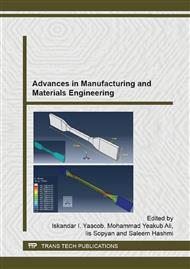p.55
p.59
p.64
p.70
p.74
p.80
p.86
p.90
p.96
Influence of Machining Parameters on Temperature when Drilling Carbon Fiber Reinforced Polymer (CFRP) Using Coated Diamond Drills
Abstract:
As the tendency towards weight reduction and low fuel consumption seems to drive the increased use of advanced exotic materials such as composites, titaniums and Inconels in the aerospace industry, the need for machining remains in aircraft industries as a post-processing operation. In the present work, the investigation of the influence of machining parameters on surface temperature when drilling CFRP using 4 mm-diameter 2-fluted carbide end-mill coated with diamond is presented. The temperature was examined on Thermal Gun Quicktemp 860-T1 sensor and analysed based on analysis of variance (ANOVA) of Central Composite Design of experiments and a first order mathematical model has been developed to predict temperature values for range of machining parameters used in the study. The relationship between the machining variables and output variables is established. It was found that the lowest temperature (32.2°C) was generated at rotational speed, 537 rpm and feed rate, 180 mm/min and at the highest temperature (39.1°C) generated at rotational speed, 4400 rpm and feed rate, 270 mm/min.
Info:
Periodical:
Pages:
74-79
Citation:
Online since:
July 2015
Price:
Сopyright:
© 2015 Trans Tech Publications Ltd. All Rights Reserved
Share:
Citation:


